Church of the Savior on Blood
| The Church of the Savior on Spilled Blood Церковь Спаса на Крови (Russian) | |
|---|---|
 | |
| Basic information | |
| Location | St. Petersburg, Russia |
| Geographic coordinates | 59°56′24″N 30°19′43″E / 59.94000°N 30.32861°ECoordinates: 59°56′24″N 30°19′43″E / 59.94000°N 30.32861°E |
| Affiliation | Russian Orthodox |
| Ecclesiastical or organizational status | State Historical Museum |
| Status | Secularized (1930's) |
| Website | Savior on the Spilled Blood |
| Architectural description | |
| Architect(s) | Alfred Alexandrovich Parland, Archimandrite Ignaty (Ivan Malyshev) |
| Architectural type | Church |
| Architectural style | Romantic Nationalism |
| Groundbreaking | 1883 |
| Completed | 1907 |
The Church of the Savior on Spilled Blood (Russian: Церковь Спаса на Крови, Tserkovʹ Spasa na Krovi) is one of the main sights of St. Petersburg, Russia. Other names include the Church on Spilled Blood (Russian: Церковь на Крови, Tserkov’ na Krovi), the Temple of the Savior on Spilled Blood (Russian: Храм Спаса на Крови, Khram Spasa na Krovi), and the Cathedral of the Resurrection of Christ (Russian: Собор Воскресения Христова, Sobor Voskreseniya Khristova).
This Church was built on the site where Emperor Alexander II was fatally wounded in March 1881.The church was built between 1883 and 1907. The construction was funded by the imperial family.[1]
History
Construction began in 1883 during the reign of Alexander III. The church was dedicated to be a memorial to his father, Alexander II.[2] Estimates suggest that the construction cost 4.5 million rubles. The construction was completed during the reign of Nicholas II in 1907. Funding was provided by the Imperial family with the support of many private donors.
The Church is prominently situated along the Griboedov Canal; paved roads run along both sides of the canal. On March 13, 1881 (Julian date: March 1), as Tsar Alexander's carriage passed along the embankment, a grenade thrown by an anarchist conspirator exploded. The tsar, shaken but unhurt, got out of the carriage and started to remonstrate with the presumed culprit. A second conspirator took the chance to throw another bomb, killing himself and mortally wounding the tsar. The tsar, bleeding heavily, was taken back to the Winter Palace where he died a few hours later.
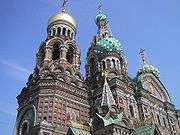
A temporary shrine was erected on the site of the attack while plans and fundraising for a more permanent memorial were undertaken. In order to build a permanent shrine on the exact spot where the assassination took place, it was decided to narrow the canal so that the section of road on which the tsar had been driving could be included within the walls of the church. An elaborate shrine, in the form of a ciborium, was constructed at the end of the church opposite the altar, on the exact place of Alexander's assassination. It is embellished with topaz, lazurite and other semi-precious stones, making a striking contrast with the simple cobblestones of the old road, which are exposed in the floor of the shrine.[3]
Architecture
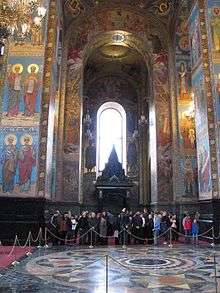
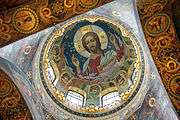

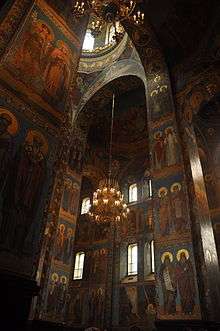
Architecturally, the Cathedral differs from St. Petersburg's other structures. The city's architecture is predominantly Baroque and Neoclassical, but the Savior on Blood harks back to medieval Russian architecture in the spirit of romantic nationalism. It intentionally resembles the 17th-century Yaroslavl churches and the celebrated St. Basil's Cathedral in Moscow.[4]
The Church contains over 7500 square meters of mosaics—according to its restorers, more than any other church in the world. This record may be surpassed by the Cathedral Basilica of St. Louis, which houses 7700 square meters of mosaics. The interior was designed by some of the most celebrated Russian artists of the day—including Viktor Vasnetsov, Mikhail Nesterov and Mikhail Vrubel — but the church's chief architect, Alfred Alexandrovich Parland, was relatively little-known (born in St. Petersburg in 1842 in a Baltic-German Lutheran family). Perhaps not surprisingly, the Church's construction ran well over budget, having been estimated at 3.6 million rubles but ending up costing over 4.6 million. The walls and ceilings inside the Church are completely covered in intricately detailed mosaics — the main pictures being biblical scenes or figures — but with very fine patterned borders setting off each picture.
Russian Revolution of 1917
In the aftermath of the Russian Revolution, the church was ransacked and looted, badly damaging its interior. The Soviet government closed the church in 1932.[5] During the Second World War when many people were starving due to the Siege of Leningrad by Nazi German military forces, the church was used as a temporary morgue for those who died in combat and from starvation and illness. The church suffered significant damage. After the war, it was used as a warehouse for vegetables, leading to the sardonic name of Saviour on Potatoes.
Modern usage
In July 1970, management of the Church passed to Saint Isaac's Cathedral and it was used as a museum. The proceeds from the Cathedral funded the restoration of the Church. It was reopened in August 1997,[6] after 27 years of restoration, but has not been reconsecrated and does not function as a full-time place of worship. The Church of the Saviour on Blood is a Museum of Mosaics. In the pre-Revolution period it was not used as a public place of worship. The church was dedicated to the memory of the assassinated tsar and only panikhidas (memorial services) took place. The Church is now one of the main tourist attractions in St. Petersburg.
Holy Gates
In 2005 the State Museum of St.Isaac's Cathedral began a new project for the recreation of the Holy Gates (permanently lost in the 1920s during the Soviet period). Entirely produced with enamels and based on the pictures and lithographies of the time, the new Holy Gates have been designed by V. J. Nikolsky and S. G. Kochetova, while famous enamel artist L. Solomnikova and her atelier have been assigned the task to produce the Holy Gates, whose reconsecration has been celebrated by Orthodox bishop Amvrosij of Gatchina on 14 March 2012, the 129th anniversary of Alexander II's assassination.[7]
Cultural references


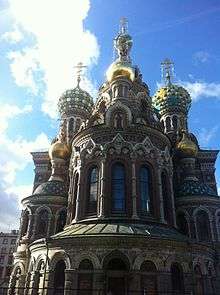
The church appears on the cover of the 2011 contemporary classical album Troika.
References
- ↑ "The Church of Our Savior on the Spilled Blood". Saint-Petersburg.com. Saint-Petersburg.com. 2015-03-29. Retrieved 2015-03-29.
- ↑ http://www.saint-petersburg.com/cathedrals/church-resurrection-jesus-christ/
- ↑ "Church of the Savior on Blood, St. Petersburg". Sacrade Places. 2015-03-29. Retrieved 2015-03-29.
- ↑ http://www.saint-petersburg.com/cathedrals/church-resurrection-jesus-christ/
- ↑ http://www.saint-petersburg.com/cathedrals/church-resurrection-jesus-christ/
- ↑ http://www.saint-petersburg.com/cathedrals/church-resurrection-jesus-christ/
- ↑ "A Russian Moment No 36 - Sanctuary and Royal Gates, Church of the Saviour on Spilled Blood, St. Petersburg". Royal Russia. Royal Russia. 2014-05-04. Retrieved 2015-03-29.
External links
| Wikimedia Commons has media related to Church of the Saviour on the Blood. |
- Official web site of the Museum
- Church of the Resurrection of Jesus Christ
- On-line web-camera Church on Spilled Blood
- View of the cathedral on January 12, 2003
- Independent site about the Church on Spilled Blood
- "Temples of Russia" - 3D model
- Photosynth of the inside
- Church of the Savior on Spilled Blood (Saint Petersburg)